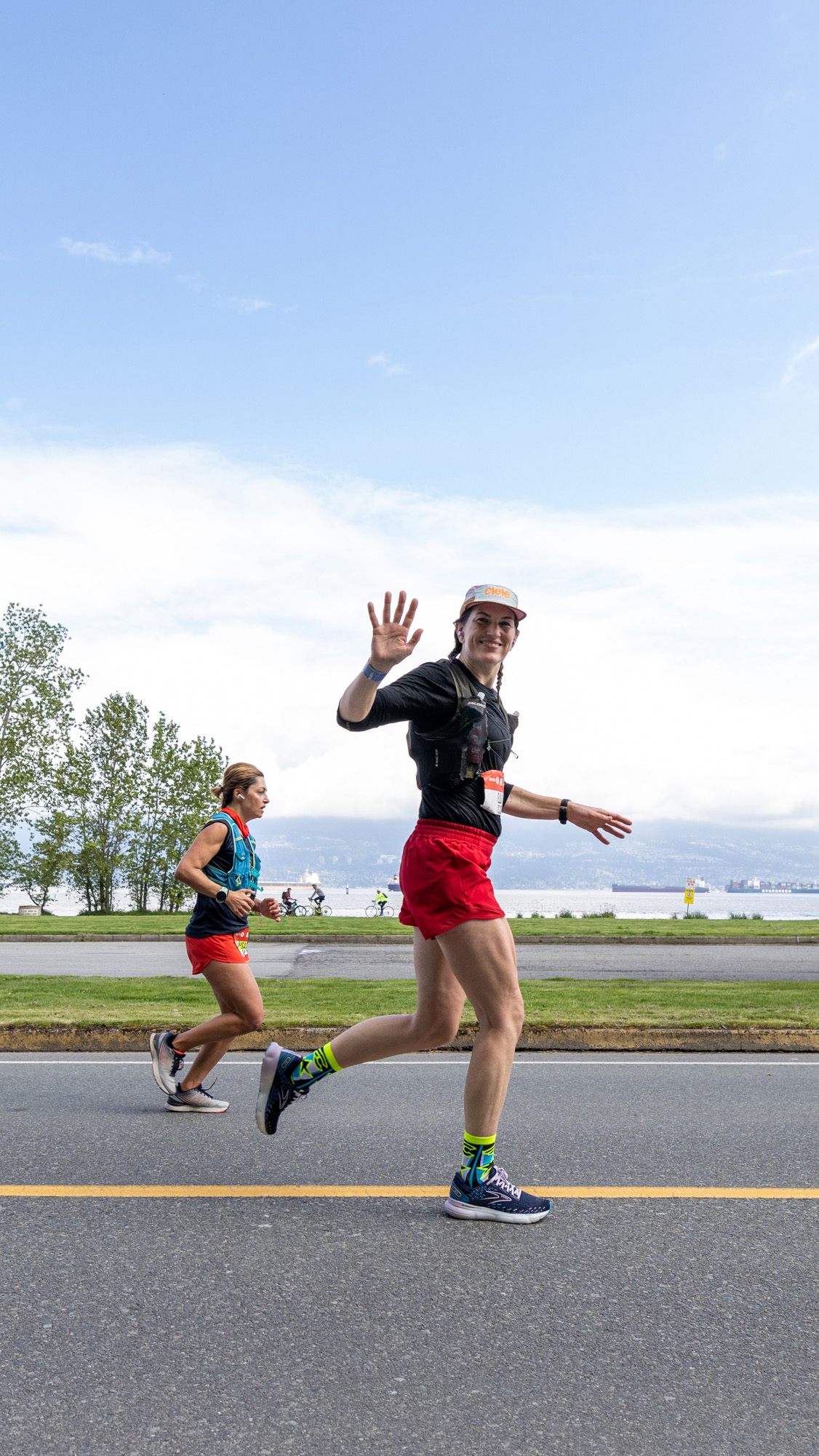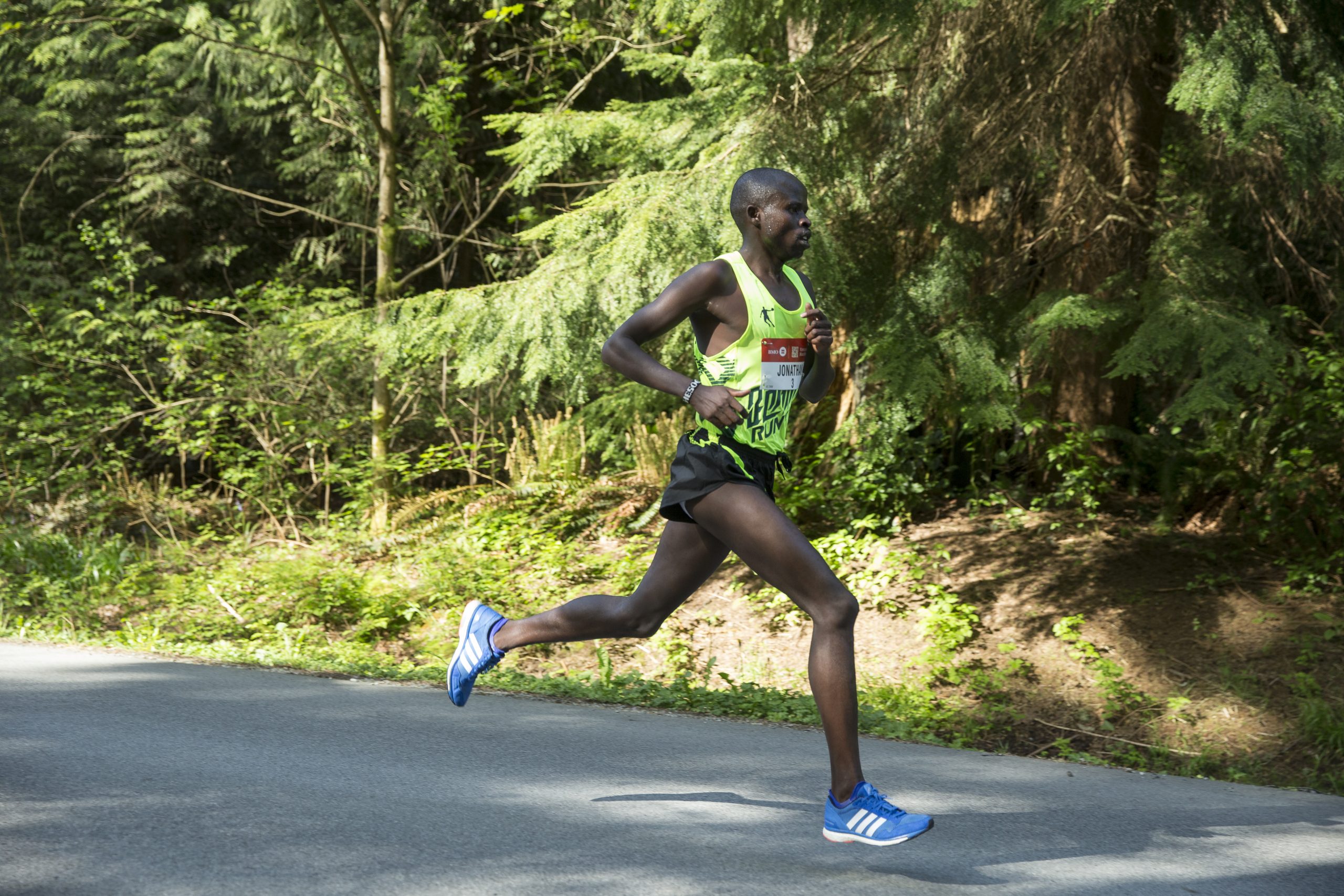RESOURCES
Training Tips, running advice + moreTips
Runner Tips
Overview
Here’s some runner tips for your next race.
Runner Lingo
Essential Terminology for Every Runner
Welcome to the world of runners, where a unique language and camaraderie thrive alongside pounding footsteps. From pacer to taper tantrum, foam rolling to negative split, this list of runners’ lingo will guide you through the terminology that fuels the passion of the running community.
- Bonk/Hit the wall: Bonk, also known as hitting the wall, refers to a sudden and extreme fatigue or exhaustion experienced by a runner during a race or long run. It usually occurs when the body’s glycogen stores are depleted, resulting in a significant decrease in energy levels.
- BQ: Short for ‘Boston Qualifier’. It signifies a runner who has achieved a qualifying time for the prestigious Boston Marathon.
- Cadence: Cadence refers to the number of steps a runner takes per minute. It is often measured in steps per minute or strides per minute (spm). A higher cadence is generally associated with better running efficiency and reduced risk of injury.
- Carb-loading: The practice of increasing carbohydrate intake before a long-distance event or a demanding training run. It helps maximize glycogen stores in the muscles for sustained energy during the exercise.
- Chafing: The discomfort or irritation caused by clothing rubbing against the skin or skin-to-skin friction. It often becomes noticeable after a run, particularly in areas where excessive moisture or repetitive motion occurs.
- DNF: Stands for ‘Did Not Finish’. It refers to a participant who did not complete a race, either due to injury, exhaustion, or other reasons.
- DNS: Stands for ‘Did Not Show’ or ‘Did Not Start’. It refers to a participant who registered for a race but did not show up on the race day.
- Easy run: A run performed at a comfortable pace where you can easily hold a conversation. It helps promote recovery, build endurance, and improve aerobic capacity without placing excessive stress on the body.
- Fartlek: A training technique that involves alternating between periods of fast running and slower recovery periods. It adds variety to your workouts and helps improve speed and endurance.
- Foam rolling: Involves use of a cylindrical foam roller to apply pressure on muscles and fascia, helping to improve flexibility, reduce muscle soreness, and aid in recovery.
- IT (Iliotibial) Band: The IT band is a thick band of tissue that runs along the outside of the thigh, connecting the hip to the knee. IT band syndrome is a common injury among runners, characterized by pain or inflammation on the outer knee. ‘IT’ is often used as shorthand for the iliotibial band.
- LSD (Long Slow Distance): The longest run of the week, typically constituting around 30% of your total weekly distance. It is taken at a slow, comfortable pace to build endurance and mental resilience.
- Negative split: Negative split refers to running the second half of a race or training run faster than the first half. It is a strategy often used by experienced runners to conserve energy and finish strong.
- Pace: The speed at which you run, typically measured in minutes per mile or kilometres. Understanding and maintaining a consistent pace is essential for achieving specific training goals and race strategies.
- Pacer: A pacer is a runner who sets a specific pace during a race or training run to help others achieve their desired finishing time.
- PR/PB: PR stands for Personal Record, and PB stands for Personal Best not Peanut Butter. They both refer to an individual runner’s fastest time in a specific race distance.
- Runner’s high: Runner’s high is a euphoric feeling or sense of well-being experienced by some runners during or after a run. It is attributed to the release of endorphins, natural mood-enhancing chemicals produced by the body.
- Taper: Tapering refers to the reduction in training volume and intensity leading up to a race. It allows the body to recover and replenish energy stores, ensuring optimal performance on race day.
- Taper tantrum: Taper tantrum refers to the restlessness or irritability experienced by some runners during the taper period. Since the training volume decreases, some runners may feel anxious or eager to run more.
- Tempo Run: Is a run that is at approximatly 80-90% of your max effort, you should be able to talk in short sentences but not hold a full conversation. Tempo runs improves endurance and speed by training your body to handle prolonged effort.
- Warm-up: A warm-up is a step you don’t want to skip. It includes short, easy exercises that help your body get ready for a more intense workout. This can involve dynamic stretches, a light jog, or strides.
Do you have any running terms you think should be on our list? @ us on Instagram @runvancanada
Running Technique
Top tips to improve your running technique
Enhance your running technique with these tips.
- Posture: Maintain a tall, upright posture with your head up, shoulders down, and arms relaxed. Avoid slouching and keep your chest open.
- Forward Lean: Lean slightly forward from your ankles, not from your waist, to generate forward momentum and improve your overall efficiency.
- Foot Strike: Aim to land on the mid or forefoot rather than the heel to promote a more efficient and natural running gait.
- Cadence: Focus on a higher cadence, or the number of steps per minute, as a higher cadence is generally associated with better running efficiency.
- Relaxed Hands: Keep your hands relaxed and avoid making fists. Imagine holding a potato chip, this may help with a relaxed hand position.
- Engage Your Core: Activate core muscles to maintain a stable, upright posture. This will enhance your running efficiency and overall form.
- Arm Swing: Maintain a relaxed and controlled arm swing as arms counterbalance your leg movements, aiding in propulsion and balance.
- Breathing: Find a comfortable rhythm with your breating. Focus on deep belly breaths to maximize oxygen intake and support your performance.
- Stride: Develop an efficient stride length, neither too short nor too long. Find a smooth and controlled stride to optimize your running technique.
- Hip Stability: Engage your core muscles to stabilize your hips while running. A strong and stable core helps maintain proper alignment.
- Running Drills: Incorporate running drills such as the ABCs of Agility, Balance, Coordination, to improve your form, technique and athleticism.
- Mindful Relaxation: Check in with your body and release unnecessary tension. Relax your jaw, shoulders, and any other areas where you tend to hold tension. This promotes a more fluid and efficient running motion, allowing you to conserve energy and reduce the risk of injury.
Remember to gradually implement these tips into your running routine and allow yourself time to adapt and improve. Consistency and patience are key to refining your running technique and achieving your goals.
Pay attention to the recovery phase of your running stride. After pushing off the ground, allow your leg to swing naturally forward, maintaining a relaxed and efficient movement
set yourself up for Success
10 Tips to Help You Run Your Best Race
To help you achieve your best performance, here’s a Top 10 list covering various aspects of preparation, from training to race-day tactics.
- Develop a Training Plan: Create a well-structured training plan that includes a balance of long runs, speed work, tempo runs, and recovery days. Gradually increase your mileage and incorporate specific marathon-focused workouts to build endurance and speed.
- Prioritize Long Runs: Long runs are the cornerstone of marathon training. Gradually increase your long-run distance, mimicking the marathon distance in your training, to build both physical and mental endurance.
- Practice Race Pace: Incorporate race-pace training runs to familiarize your body and mind with the desired marathon pace. This will help you maintain a consistent pace on race day and avoid starting too fast.
- Nutrition and Hydration: Pay attention to your nutrition and hydration throughout. Experiment with fuelling strategies during long runs to find what works best for you, and practice taking fluids and gels during training to avoid any surprises on race day.
- Mental Preparation: Train your mind to stay focused, positive, and resilient during the marathon. Practice visualization, positive affirmations, and mental toughness techniques to overcome fatigue and push through challenging moments.
- Race-Day Strategy: Plan your race-day strategy based on your training and experience. Break the race into smaller segments, set realistic goals, and pace yourself accordingly. Consider negative splits, where you run the second half of the marathon slightly faster than the first.
- Dress for Success: Wear comfortable, moisture-wicking clothing and appropriate running shoes that you’ve trained in extensively. Avoid trying anything new on race day to prevent discomfort or blisters.
- Use Aid Stations Wisely: Familiarize yourself with the locations and layout of aid stations on the course. Practice taking water and drinks on the run to maintain hydration and replenish electrolytes. Grab only what you need and keep moving forward. Read more on Mastering the Aid Stations.
- Stay Mentally Engaged: Keep your mind focused and engaged throughout the race. Draw motivation from the crowd, fellow runners, and your own mental strategies. Break the race into smaller milestones and celebrate each accomplishment along the way.
- Enjoy the Experience: Remember to enjoy the journey and savor the marathon experience. The training and dedication you’ve put in are remarkable achievements in themselves. Embrace the excitement, soak in the atmosphere, and celebrate crossing the finish line.
By following these ten tips, you can optimize your training, mental preparation, and race-day strategy, setting yourself up for success and an unforgettable experience. Stay focused, positive, and trust in your training – believe in yourself as you embark on this incredible journey to run your best marathon.
What to Expect
Your First Running Race
Participating in your first running race is an exciting milestone in your running journey. Whether it’s a fun run, a 5KM, or a longer distance race, understanding what to expect can help calm any nerves and ensure you have a positive and enjoyable experience. This list will guide you through what you can anticipate from your first running race, from pre-race preparations to the post-race celebrations.
- Pre-Race Preparations: Arrive early to the race venue to collect your race bib and timing chip, and familiarize yourself with the race logistics and facilities. Use the opportunity to warm up, stretch, and mentally prepare for the race ahead.
- Race Atmosphere: Expect an energetic and lively atmosphere filled with fellow runners, volunteers, and spectators cheering you on. The collective excitement and camaraderie among participants can be truly motivating and inspiring.
- Race Start: Be prepared for a surge of adrenaline as the race begins. Runners will start at different paces, so find your comfortable spot and settle into your rhythm. Don’t be surprised if the initial moments feel crowded; it will soon spread out as runners find their pace.
- Aid Stations: Throughout the race course, you’ll encounter aid stations offering water, sports drinks, and sometimes snacks. Practice taking fluids on the run during your training to ensure a smooth experience during the race. Read more on Mastering the Aid Stations.
- Crowds and Support: Expect enthusiastic cheers and encouragement from spectators along the race route. Their support can provide a much-needed boost, so soak in the positive energy and let it propel you forward.
- Pacing and Strategy: Focus on running at a pace that feels sustainable for the distance. Stick to your race plan and avoid starting too fast to prevent burnout later. If needed, use the presence of pace setters or fellow runners with similar goals as a guide.
- Mental Challenges: During the race, you may face mental hurdles and moments of fatigue. Stay positive and break the race into smaller milestones. Draw inspiration from your training, remind yourself of your goals, and visualize crossing the finish line.
- Post-Race Celebrations: Upon crossing the finish line, revel in your accomplishment. Receive your finisher’s medal, hydrate, and take time to cool down and stretch. Enjoy the post-race atmosphere, connect with other runners, and celebrate your achievement.
- Race Results and Reflection: After the race, check your official time and reflect on your performance. Be proud of your efforts and consider it a stepping stone for future races. Identify areas for improvement and adjust your training accordingly.
- Post-Race Recovery: Allow yourself time to recover after the race. Focus on rest, rehydration, and gentle activities to aid in recovery. Listen to your body and gradually ease back into training.
By knowing what to expect, you can approach the race with confidence and enjoy every moment, from the anticipation at the start line to the thrill of the finish line. Embrace the journey, celebrate your efforts, and let your first race be the beginning of many more fulfilling running adventures.
Mastering Aid Stations
Squeeze and Sip
Drinking water from aid stations during a race is an essential skill that can make a big difference in your performance and hydration levels. Here’s a short guide on how to effectively drink water from aid stations and properly dispose of the cups provided by the race organization:
- Maintain Control: As you approach the aid station, move towards the side to avoid obstructing other runners. Maintain a steady pace or slow down slightly to maintain control while drinking.
- Pinch the Cup: When a volunteer offers you a cup, pinch the top rim between your thumb and index finger to create a small spout. This technique helps prevent water from splashing out and allows for easier drinking while running.
- Take Small Sips: As you continue running, bring the cup to your mouth and take small, controlled sips of water. Avoid gulping down large amounts at once, as it may lead to discomfort or water going down the wrong way.
- Keep Moving Forward: While drinking, continue moving forward. If necessary, briefly slow down or walk to ensure you can safely and comfortably consume the water without choking or spilling.
- Recycle the Cup: After you’ve finished drinking, crush the cup in your hand to make it easier to hold onto. Look for designated bins provided by the race, typically placed a short distance after the aid station. Aim for the bins and drop the cup in without stopping or littering. If you miss the aid station, carry the cup with you until the next station. Never litter.

Avoid Injury
10 Essential Tips for Preventing Running Injuries
Run safe and strong and stay injury free on your run.
Running is a fantastic way to stay fit and enjoy the outdoors, but it’s important to prioritize injury prevention to ensure long-term health and running longevity. Here, we provide you with ten valuable tips to help you stay safe and injury-free while running. By implementing these strategies, you can minimize the risk of running-related injuries and continue pursuing your running goals with confidence.
- Warm Up: Start each run with a dynamic warm-up routine to prepare your muscles and joints for the demands of running. Incorporate exercises like leg swings, high knees, and lunges to activate and loosen up your body.
- Wear the right Gear: Invest in proper running shoes that provide adequate support and cushioning for your foot type and running style. Replace worn-out shoes regularly to maintain optimal shock absorption and reduce the risk of overuse injuries.
- Gradual Mileage Increase: Avoid sudden spikes in mileage to prevent overuse injuries. Gradually increase your weekly mileage by no more than 10% per week to give your body time to adapt and recover.
- Cross-Train: Incorporate cross-training activities like swimming, cycling, or strength training into your routine. This helps balance muscle groups, strengthens supporting muscles, and reduces the repetitive impact of running.
- Listen to Your Body: Pay attention to any warning signs of pain or discomfort during or after running. If something feels off, take a break or modify your training to allow for rest and recovery. Pushing through pain can lead to more severe injuries.
- Focus on Technique: Focus on maintaining good running form, including proper posture, relaxed shoulders, and a midfoot strike. Avoid overstriding and aim for a cadence of around 180 steps per minute to reduce stress on your joints.
- Stretch: Incorporate regular stretching into your routine to improve flexibility and prevent muscle imbalances. Focus on key areas like calves, hamstrings, quadriceps, and hip flexors.
- Strength Train: Incorporate regular strength training exercises, focusing on key areas like the core, hips, and lower body. Building strength can help improve running efficiency, stability, and injury resilience.
- Hydrate: Stay properly hydrated before, during, and after your runs. Dehydration can affect performance and increase the risk of muscle cramps and fatigue. Drink water regularly throughout, and consider carrying water with you on longer runs.
- Rest and Recover: Allow your body enough time to rest and recover between runs. Include easy or rest days in your training schedule to give your muscles and connective tissues time to repair and rebuild.
You can significantly reduce the risk of running injuries and enjoy a safe and fulfilling running experience by following these tips. Prioritize warm-ups, proper gear, gradual mileage increase, cross-training, and rest. Listen to your body, maintain good technique, stretch, hydrate adequately, and consider incorporating strength training into your routine. Embrace injury prevention as an essential part of your running journey, and you’ll be able to enjoy the many benefits of running for years to come.

Cross-Training
10 Cross Training Exercises for Long-Distance Runners
Cross training is a valuable addition to the training regimen of long-distance runners. By engaging in alternative exercises, you can improve overall fitness, prevent overuse injuries, and enhance performance. Let’s explore ten effective cross training exercises specifically beneficial for long-distance runners. From cycling to yoga and beyond, these activities will provide variety, strength, and conditioning to support your running goals.
- Cycling: Hop on a bike to enjoy low-impact cardiovascular exercise that strengthens leg muscles while giving your joints a break from the repetitive pounding of running. Cycling builds endurance, improves aerobic capacity, and helps maintain a high level of fitness.
- Swimming: Dive into the pool for a full-body workout that is gentle on your joints. Swimming engages various muscle groups, improves cardiovascular fitness, and enhances lung capacity. It also aids in recovery by promoting active rest and reducing muscle soreness.
- Climbing: Indoor or outdoor climbing challenges your strength, balance, and mental focus. It targets upper-body muscles while building core stability, improving grip strength, and enhancing overall body control.
- Yoga: Practicing yoga enhances flexibility, balance, and body awareness. It also helps alleviate muscle tightness and reduces the risk of injuries. Incorporate yoga sessions to improve posture, breathing, and overall relaxation.
- Nordic Skiing: During the winter months, Nordic skiing provides a fantastic full-body workout that enhances cardiovascular fitness and strengthens both upper and lower body muscles. It also improves endurance and can be a fun way to enjoy the snowy outdoors.
- Hiking: Hit the trails for a challenging and scenic cross-training activity. Hiking builds lower-body strength, endurance, and stability while allowing you to explore nature and enjoy the benefits of outdoor exercise.
- Barre: Barre workouts blend elements of ballet, Pilates, and yoga to target specific muscle groups, particularly the legs, core, and glutes. This improves balance, flexibility, and strength, and complements your running routine.
- Kickboxing: Engage in high-intensity kickboxing classes to improve cardiovascular fitness, agility, and overall body strength. Kickboxing combines martial arts techniques with cardio exercises, providing a dynamic and challenging cross-training option.
- Strength Training: Incorporate regular strength training sessions to build overall body strength, including exercises such as squats, lunges, deadlifts, and core work. Strength training helps prevent muscle imbalances, enhances running economy, and reduces the risk of injuries.
- Pilates: Pilates focuses on core strength, stability, and flexibility. By targeting deep abdominal muscles, it improves posture, body alignment, and overall muscular balance, providing support for long-distance runners.
Adding cross training exercises into your routine as a long-distance runner offers a multitude of benefits. From cycling and swimming to climbing and yoga, these activities enhance your overall fitness, strengthen different muscle groups, prevent injuries, and provide mental and physical variety. Explore these ten cross training exercises, embrace new challenges, and discover how they complement and enhance your running performance. Expanding your fitness repertoire, you’ll become a more well-rounded and resilient long-distance runner.
Comfortably Pacing
How to find a comfortable running pace
Finding a comfortable run pace is crucial for enjoying your runs and maintaining endurance. Here are three tips to help you establish a comfortable pace:
- Slow down: Many beginners make the mistake of starting their runs too fast, leading to early fatigue. Begin at a relaxed, conversational pace, even if it feels slower than you expect. This allows your body to warm up gradually and helps you settle into a sustainable rhythm.
- Check your breath: Pay attention to your breathing during the run. If you’re gasping for air or struggling to speak in full sentences, you’re likely running too fast. Slow down until you can breathe comfortably and have a conversation without feeling breathless. This indicates that you’re running at an appropriate pace for your fitness level.
- Chat test: A useful method to gauge your running pace is the ‘chat test’. If you’re running with a partner or in a group, attempt to hold a conversation while running. If you can comfortably talk without running out of breath, you’re likely running at an appropriate pace. If you find it challenging to speak, slow down until you can maintain a conversation effortlessly.

It’s perfectly fine to walk if needed. Incorporating walk breaks during your runs can help you build endurance and maintain a comfortable pace. As you progress and your fitness improves, you’ll find that your comfortable pace will naturally increase. Enjoy your runs, listen to your body, and find the pace that allows you to run comfortably and consistently.
Racing Tips
10 things to know before racing
Embarking on a running journey is a thrilling endeavour that requires careful preparation and mindful execution. As you lace up your running shoes and set your sights on the finish line, it’s a good idea to equip yourself with a comprehensive understanding of what lies ahead. From training strategies to hydration solutions, here are 10 crucial insights to consider before taking on your next challenge.
- Start training early: The key to a successful build is a good training plan. Try to start training 16-20 weeks before race day.
- Build up mileage gradually: Gradually increase your weekly mileage to avoid injury and burnout.
- Incorporate cross-training: Cross-training, such as cycling or swimming, can help you build endurance and prevent injury.
- Pay attention to your nutrition: Make sure you get enough carbohydrates, protein, and healthy fats to fuel your training and recovery.
- Stay hydrated: Optimal performance hinges on proper hydration. Drink plenty of water before, during, and after. Also try electrolytes.
- Listen to your body: If you’re feeling tired or have any pain or discomfort, take a break or adjust your training plan accordingly.
- Get proper rest: Aim for 7-8 hours of sleep each night to help your body recover and prepare for your next run.
- Practice your race day routine: Experiment with different pre-race meals, clothing, and gear during your training to find what works.
- Don’t try anything new race day: Stick to what you know works for you. Don’t try new foods, clothing, or gear on race day.
- Enjoy the experience: Remember, running a race is an accomplishment in itself. Enjoy the journey and the feeling of that Finish Line.
Start with Run/Walk
Getting started: The run/walk program for beginners
Getting started on your running journey can be both exciting and challenging, especially for beginners. One effective approach for beginners is the run/walk program, which combines intervals of running and walking to gradually build endurance and prevent overexertion. Here’s a simple guide to help you get started with the run/walk program:
- Set realistic goals: Begin by setting achievable goals based on your current fitness level. Whether it’s completing a 5KM race or simply being able to run continuously for a certain duration, having specific goals will keep you motivated and focused.
- Warm-up and cool-down: Prior to each run, warm up with some dynamic stretches or a brisk walk to prepare your muscles and joints. After your run, cool down with a few minutes of walking and static stretching to aid in recovery.
- Start with a run/walk ratio: Begin by alternating between running and walking intervals. For example, start with a ratio of 1 minute of running followed by 2 minutes of walking. Repeat this cycle for a designated duration or distance.
- Gradually increase running time: As you progress, aim to increase the duration of your running intervals while decreasing the walking intervals. For instance, you could progress to a 2-minute run and 1-minute walk ratio, then gradually move towards longer continuous runs.
- Listen to your body: Pay attention to any signs of fatigue or discomfort during your runs. If needed, adjust the run/walk ratio or decrease the overall intensity to prevent injury and promote a sustainable training routine.
- Gradually reduce walking intervals: Over time, aim to reduce or eliminate the walking intervals as your endurance improves. Gradually increase the duration of your continuous running segments until you can comfortably run without walking breaks.
Remember, everyone progresses at their own pace, so be patient with yourself. Consistency and gradual progression are key. As you continue with the run/walk program, you’ll gradually build endurance, improve fitness and gain confidence in your running abilities. Always listen to your body, enjoy the process, and celebrate each milestone along the way. Happy running!
Taper Time
What is the optimal time for a taper?
The optimal timing for a taper in Marathon training is a pivotal aspect that can significantly impact an athlete’s performance on race day. Tapering involves a deliberate reduction in training load to strike a balance between recovery and maintaining peak fitness. The ideal duration for a Marathon taper typically ranges from 2 to 3 weeks, though individual variations and specific training plans can influence this timeframe.
Marathon runners often engage in high-volume, high-intensity training to build endurance and strength. As the race approaches, a taper allows the body to recover from the accumulated fatigue while preserving the adaptations gained from months of training. A 2 to 3-week taper provides adequate time for muscle repair, glycogen replenishment, and the reduction of residual soreness. This period allows runners to maintain their aerobic capacity while ensuring their legs feel fresh and energized on race day.
Fine-tuning the taper duration involves understanding the athlete’s response to reduced training and recognizing the point of diminishing returns. Some runners might benefit from a slightly shorter taper, as a prolonged reduction in training intensity could lead to detraining effects. Others may find that a longer taper enables them to fully recover and feel at their best. Try to optimize the taper’s length for yourself. In the end, a well-calibrated taper is an essential tool that can contribute to a successful marathon experience.
Tapering for a Marathon
Advice for the Week Before Your Race
Tapering is a crucial phase in marathon training that involves reducing mileage and intensity in the week leading up to the race. This period allows your body to recover, recharge, and be in optimal condition for race day. In this article, we’ll provide you with valuable advice on how to effectively taper for a marathon, ensuring you arrive at the starting line feeling fresh, confident, and ready to perform at your best.
- Reduce Mileage: Gradually decrease your weekly mileage during the taper week. Aim for a reduction of around 20-30% compared to your peak training volume. This reduction will allow your body to recover while maintaining fitness levels.
- Maintain Intensity: While reducing mileage, maintain the intensity of your runs. Include some shorter, faster-paced runs or intervals during the taper week to keep your legs sharp and maintain your cardiovascular fitness.
- Focus on Quality Rest: Prioritize getting enough sleep and allow your body to recover fully. Aim for 7-9 hours of sleep each night during the taper week to promote muscle repair and overall recovery.
- Stay Hydrated and Nourished: Continue to hydrate properly and eat a balanced diet during the taper week. Ensure you consume enough carbohydrates to replenish glycogen stores and support optimal performance on race day.
- Avoid New Experiments: The week before your marathon is not the time to try new shoes, gear, or fueling strategies. Stick to what you know works well for you to avoid any unwanted surprises or discomfort during the race.
- Short, Easy Runs: Include a couple of short, easy runs during the taper week to keep your legs active and maintain a sense of routine. These runs should be at a comfortable pace, focusing on maintaining good form and loosening up.
- Mental Preparation: Use the taper week to visualize your race and mentally prepare for the marathon. Visualize yourself crossing the finish line strong and confident. Stay positive, trust your training, and believe in your abilities.
- Stay Relaxed: Engage in activities that help you relax and reduce stress. Whether it’s yoga, meditation, reading, or spending time with loved ones, find activities that promote mental calmness and keep your stress levels in check.
- Avoid Excessive Sitting: While it’s important to rest during the taper week, avoid excessive sitting or prolonged periods of inactivity. Engage in light activities like walking or gentle stretching to keep your muscles loose and prevent stiffness.
- Trust the Process: Finally, have faith in your training and trust the tapering process. Understand that tapering is necessary to allow your body to recover and maximize your performance on race day. Embrace the taper week as a crucial part of your marathon journey.
By following these tapering tips, you can optimize your preparation for a marathon and arrive at the starting line feeling refreshed and ready to tackle the challenge ahead. Remember to reduce mileage, maintain intensity, prioritize rest and recovery, and stay mentally focused. Trust in your training and embrace the taper week as an essential component of your marathon success. Good luck on race day!
Recover Faster
10 tips to run better and recover faster
Here are 10 tips to help you run better and recover faster, optimizing your overall performance.
- Follow a Training Program: Stick to a structured training program tailored to your goals and fitness level. Consistency and progressive overload will improve your running performance over time.
- Prioritize Nutrition: Fuel your body with a balanced diet that includes carbohydrates, proteins, and healthy fats. Proper nutrition provides the energy and nutrients needed for optimal running performance and efficient recovery.
- Maintain Hydration: Stay adequately hydrated before, during, and after your runs. Proper hydration supports optimal performance, helps prevent cramps, and aids in post-run recovery.
- Focus on Recovery: Include dedicated recovery periods in your training plan. Allow your body to rest and recover, incorporating active recovery techniques like foam rolling, stretching, or gentle cross-training activities.
- Warm-Up: Always start your runs with a proper warm-up routine. Dynamic stretches and light exercises such as ABC drills prepare your muscles, joints, and cardiovascular system for the demands of running.
- Focus on Form: Pay attention to your running form. Maintain an upright posture, relaxed shoulders, and a slight forward lean. Proper form improves efficiency, reduces the risk of injury, and enhances overall performance.
- Cool Down: Finish your runs with a cooldown period that includes gentle jogging or walking, followed by static stretches. This helps gradually decrease your heart rate and promotes muscle recovery.
- Listen to Your Body: Pay attention to any signs of fatigue, pain, or overtraining. Adjust your training intensity or take rest days as needed. Ignoring warning signs can lead to injuries and hinder your progress.
- Invest in Proper Gear: Ensure you have suitable running shoes that provide proper support and fit well. Dress appropriately for the weather conditions and consider using technical running gear that enhances comfort and performance.
- Incorporate Cross-Training: Include cross-training activities, such as cycling, swimming, or strength training, in your routine. Cross-training helps improve overall fitness, prevents overuse injuries, and gives your running muscles a break.
- Bonus Tip – Find Motivation: Discover what motivates you to run and keep that in mind during challenging times. Whether it’s setting goals, connecting with a running community, or focusing on the mental and physical benefits, motivation plays a crucial role in sustaining your running journey.
By following these tips and staying committed to your training and recovery, you can enhance your running performance, prevent injuries, and optimize your overall fitness and well-being. Remember to enjoy the process and celebrate every milestone along the way.




